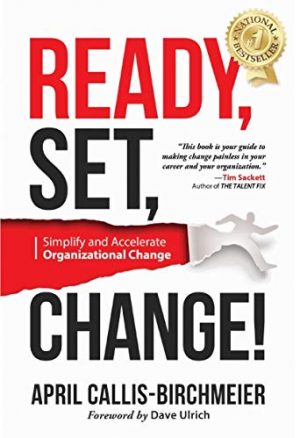READY, Set, Change!: Simplify and Accelerate Organizational Change

What surprises me the most about the world of change management is how there can continue to be new things that I learn about it. Sometimes, the things I learn are closer to me than I could have ever realized. That’s the case with April Callis-Birchmeier’s book, READY, Set, Change!: Simplify and Accelerate Organizational Change. The proximity I’m referring to here is both geographical and relational. April’s in Michigan – the next state over from my home in Indiana. Relationally, the person she used to help publish her book is someone who I see several times a year at networking events. It’s truly a small world.
Models
There are no shortage of models when it comes to change. April introduces another model – the READY model:
- R: Relevant and relatable messaging about the change
- E: Engage Leaders as sponsors and actively promote the change
- A: Advance
communication to ensure messaging is received and advocating for stakeholders - D: Develop, support, and train on process and technology
- Y: Reinforce WHY and reduce resistance to adoption
This model definitely aligns with other models. Prosci’s ADKAR model (see Successful Technology Change and ADKAR and Change Management), Kotter’s 8-Step model (see Leading Change and The Heart of Change), Stages of Change (see Motivational Interviewing), and Bridges’ Transitions Model (see Managing Transitions). It also aligns with Simon Sinek’s work in Start with Why.
More broadly, it connects with The Psychology of Hope by emphasizing the need for support and training. (See Job Aids and Performance Support for ideas on support and Efficiency in Learning, The Adult Learner, and The Art of Explanation for more on training.) In not so short, it’s sound advice for people who are looking to make change effective in their organization. So, while it’s another model to consider, it is well founded.
Setting for Success
In Collaborative Intelligence, Richard Hackman asserts that as much as 60 percent of the probability of a team’s success is based on what happens before they come together. Here, April encourages the proper preparation in the change process to lead to better chances for success. There are, of course, no guarantees, but the more work that can be done ahead of time to prepare the organization for the change that’s coming, the more likely it is they’ll be able to accept it and the initiative will be successful.
Readiness is an Emotional Choice
There is no magic formula for helping people be ready for the change. Readiness is, in fact, a personal choice. It’s a choice about how capable you feel of coping with the transition (to use Bridges’ words). This, too, is supported by evidence. Richard Lazarus, in Emotion and Adaptation, explains that our emotions are formed based on a stressor (stimulus) and our assessment of that stimulus. Individually, we can become more ready for change through developing our courage (see Find Your Courage) and our waypower – that is, our understanding of how we’ll make the change (see The Psychology of Hope).
Technology, Training, and Barriers
Demand explains that small barriers make a big difference. While it may not seem like much, sometimes the inability to find where to start can stop people from starting at all. Instead of displaying tenacity, persistence, and grit, people give up all too easily. (See Grit and Willpower for more.) Speaking as a technologist, some problems are hard to solve – and as a change specialist, some are harder to solve if you make them people problems.
There’s a tendency – particularly at the last minute – to make gaps in the technical solution a training problem. That may, or may not, be the right answer. The truth is that all gaps should be assessed from the perspective of their capacity or propensity to derail the change initiatives success. Sometimes, it’s better to delay a little, get the technology tighter, and ultimately be ahead from an adoption perspective.
An Ounce of Prevention
An ounce of prevention is often worth a pound of cure. In change management, the preparation you do can reduce the amount of time that your success will take. Reading READY, Set, Change! may be a good start to that preparation.
